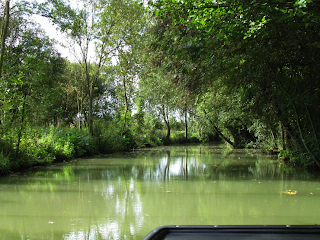A windmill near Marans. Being off-season it wasn't open at the time we were passing, but it does still operate (primarily as a tourist attraction) and produces flour which I would definitely have bought to try if it had been open. The sails are wooden slats which fan out - I think you can see in the second photo. And the weather vane is a hen and chicken.


Photos from our boat trip along the canals in the Marais. As posted in an earlier post (the one with the storks video): according to Wikipedia it covers about 970 square km , and according to our guide there are about 6000km of man-made drainage canals, as well as some natural ones. This work was started during the reign of Henri IV (1553 - 1610), who called in the Dutch experts, (just as the English did with the Norfolk fens in the early 17th century). We saw a lot of wild hops and teasels, there was also a lot of willow, ash, birch, alder and hazel. In the old days, according to our guide, they used to transport cattle from field to field on flat-bottomed "barges". I saw a night heron perched in some bushes, and a quick glimpse of a kingfisher. You can pre-book dawn or dusk boat trips which would probably be much more fruitful in terms of wildlife spotting. Introduced animals include the coypu - we saw their holes in a bank, but not any out and about.

The tiles on the roof of this little hut are typical of the region. They're made from local clay - at intervals along some of the canals you could see excavated areas at the edge where the clay had been quarried. Our guide could remember either his grandfather or father (I should have made a note, as at this stage I can't remember!) working in the clay pits. My recollection is that the guide told us the tiles were called dames (ladies) because originally they were shaped over the thigh, but quick research hasn't yet confirmed this.
 |
| Teasels |
 |
| Wild hops |
We really enjoyed our boat trip - it was shaded enough that we enjoyed the sun without getting burnt, it was very peaceful and there were no flies. We'd certainly do it again if we're back in the area, although having had a guide this time and learnt about the area we'd probably hire our own boat next time. The poling certainly doesn't look as arduous as rowing, although I am sure there's a knack to be learnt before being able to do it smoothly and evenly.































